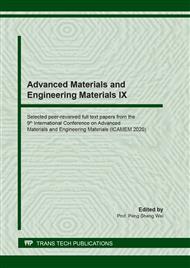p.193
p.202
p.213
p.221
p.228
p.233
p.238
p.244
p.250
Effect of Sintering Temperature on Properties and Microstructure of Alumina-Aluminum Cermet via Vacuum Sintering Method
Abstract:
In this paper, the effect on the properties of alumina/aluminum cermet by changing the sintering temperature, and comparing the advantages and disadvantages of different characterization methods and their application range, it provides a reference for selecting the characterization technology suitable for alumina/aluminum composites.Through mixing, molding, sintering, sample preparation, scanning electron microscopic observation, energy spectrometer observation and analysis, the following conclusions can be drawn: the higher the vacuum sintering temperature, the more aluminum material is melted out of the body to form aluminum balls on the surface, and the green body The more severe the cracking. When the sample is sintered at a temperature of 600 °C, the density is the highest and the appearance is the best. When the molding pressure is 40 MPa and the sintering temperature is 700 °C, the microstructure of the sintered alumina/aluminum cermet is better. It can be seen from SEM and EDS analysis that the particles are continuously distributed and the larger one is metal Al, and the particles are discontinuously distributed and finer is Al2O3.
Info:
Periodical:
Pages:
228-232
Citation:
Online since:
September 2020
Authors:
Keywords:
Price:
Сopyright:
© 2020 Trans Tech Publications Ltd. All Rights Reserved
Share:
Citation:


